Korean martial art Taekwondo (한국의 무술 ‘태권도’)
Taekwondo is a martial art that anybody can easily learn!Taekwondo is an internationally accredited sport that uses only the hands and the feet to attack and defend, without the use of any weapons.It’s a representative martial art of East Asia, alongside Chinese kung fu, or wushu, and Japanese karate.It has been called "taekwondo" since 1957, and has been continuously developed by combining the hand movements of Korea’s traditional subak martial art, and the feet movement of Korea's traditional taeggyeon martial art. Together, they form the taekwondo of today.There are many martial arts around the world, and they were mostly created to prepare against invasion. The same applies to taekwondo, and it's currently being practiced by people all over the world as a sport that trains both the body and mind.Traditional martial arts were developed during a time of tribal states and became a religious ceremony. During the Three Kingdoms of Korea, martial arts were directly related to defense as they were a major combat skill. Along with the changing times, martial arts transformed from a skill for fighting to one of training the body and mind. A poomsae, or series of movements, is the base of taekwondo. The trainee battles a virtual enemy, and gains more and more skills by connecting the basic movements of offense and defense.The name "taekwondo" means “a martial art that uses the hands and feet.” As such, it displays an array of skills using the hands and feet. Taekwondo hand movements are the most basic of actions. The following skills are directed to attack the vital points of the enemy. The jireugi uses the front of the fist. The chigi uses the back of the fist, and the jjireugi involves using the ends of the hands to attack the pressure points of the opponent. The makgi uses the outer and inner arm to block an attack.The balchagi is a kick, and is considered a beautiful movement.In international tournaments, it’s the move that garners the most points.Once proficient, the kick holds enough power to break hard materials, such as pine boards, roof tiles and even bricks.The forward kick is the most basic kick, and is predominantly used to attack the opponent’s faceor torso.The side kick attacks the opponent using the blade of the foot and heel, rotating the body sideways.Unlike the front and side kick, the thrashkick involves a rotating, spinning kick.These basic actions can be used on their own, but by combining these moves in various combinations, the attack power and artistic beauty of the martial art increases.Taekwondo originally began as a martial art, but it’s currently widening its horizons to become a performance art by incorporating a wider variety of cultural content.Based on the practitioner's restrained and splendid skill, taekwondo is now garnering attention again as a performance art worth seeing.With 209 countries as members of the World Taekwondo(WT), more than 100 million people are learning taekwondo worldwide.Taekwondo is continuously developing as a martial art that trains bodies and minds all around the world. 2017.12.30바로가기
 이 누리집은 대한민국 공식 전자정부 누리집입니다.
이 누리집은 대한민국 공식 전자정부 누리집입니다.
동영상
전체 148건
페이지 7 / 15쪽
-
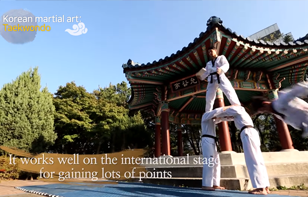 상세보기
상세보기 -
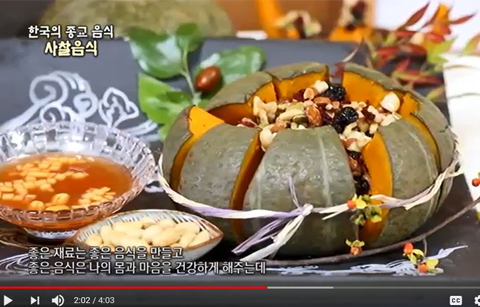 상세보기
상세보기Korean religious food, Buddhist temple food (한국의 종교 음식, 사찰음식)
해외문화홍보원과 한국문화재재단 문화유산채널이 협업하여 제작한 영상입니다.4세기 후반 한반도에 전래Late-four century A.D., when Buddhism was first introduced to Korea 한국인의 정신세계와 밀접한 관계인 불교Buddhism has still been closely related to the spirits of the Korean people since 수행과 정진을 통해 (발생)개인이 깨달음을 얻는 종교A person reaches nirvana through his/her own fulfillment and devotion in Buddhism.생활 속 실천으로 수행을 완성The fulfillment is complete when applied to everyday life사찰이 발달한 동아시아의 대승불교Mahayana Buddhism prevailed in East Asia with the development of temples사찰에 따라 발달한 독특한 음식 조리법Variety of food recipes have been developed 사용이 금지된 식재료, 육류와 오신채The characteristics of temple food is not to use meat and five sharp-tasting vegetables독특한 음식 조리법 사찰 음식A unique food recipe! We call it, 'Temple Food'사찰음식은 모든 생명을 담는 음식이에요Temple food embodies life.[인터뷰] 선재 스님 / 대한불교 조계종 사찰음식 명장 제1호 Seon-Jae, Monk / Jogye Order of Korean Buddhism, Temple Food Master No. 1육류나 어패류는 그들의 생명이 나와 다르지 않다고 해서 (살생하지 않았어요)The lives of meat and fish are not different from mine. (They do not kill)그들의 삶을 뺏어가면서 얻은 재료는 불교의 정신과 맞지 않습니다Taking the life of another for food consumption is nonsensical.불교에서 파, 마늘 등 (발생)오신채를 먹지 않는 이유?Why not green onions, or garlic? 오신채맛과 향이 맵고 강해 불교에서 금지하는 음식물로 마늘, 파, 부추, 달래, 양파를 뜻한다Five sharp-tasting vegetables foods such as garlic, green onion, chive, wild chive and onion etc. which are prohibited in Buddhism for its hot and strong spiciness.경기도 수원시 봉녕사 사찰음식 전시회Exhibition of Temple Food at Bongnyoungsa, Suwon, Gyeonggi Province민간 음식을 바탕으로 불교의 정신을 더한 음식Temple food contains the spirit of Buddhism through cooking살아있는 생명을 해치는 살생이 금지돼 육류 제외No killing of living things is allowed, thus no meat.맵고 향이 강해 정신을 흩뜨리는 오신채 제외No five sharp-tasting vegetables that can distress our mind is allowed, either.좋은 재료는 좋은 음식을 만들고 좋은 음식은 나의 몸과 마음을 건강하게 해주는데Making good food with good ingredients makes our body and mind healthier.그 음식 속에는 땅, 물, 바람, 공기들도 맑고 건강하게 살 수 있는 에너지를 주는 것이 사찰음식이에요Temple food gives us enough energy to live a healthy life as it contains elements of the earth, water, wind and air, all found in nature.자연과 사람 모두를 생각하는 건강식Temple food make both nature and human all healthy.[인터뷰] 최윤정 Choi Yun-Jeong스님들이 하셔서 맛이 특이할 것 같았는데 먹어보니 기름기없이 담백해요I thought it quite unusual since a monk prepares it. I tried it, and it was non-greasy, pretty good.[인터뷰] 홍경옥 Hong Kyoung-Ok채소만 넣고 고기없이 맛있게 만들었어요 건강에 좋은 거죠It’s made with only vegetables and contains no meat. It’s good for the health.채소가 많이 들어가고 참기름 넣어 향기도 나고 맛이 참 좋은 것 같아요With this much vegetables and sesame oil, it smells and tastes good, too.[인터뷰] 선재 스님 / Seon-Jae, Monk 대한불교 조계종 사찰음식 명장 제1호 / Jogye Order of Korean Buddhism, Temple Food Master No. 1음식은 건강을 주는 거잖아요 서양은 건강보다 맛을 위주로 음식을 만들거든요Food gives us health. But there’s more taste than health value in western food. 자연의 생명을 살리면서 건강하게 해주는 음식이 무엇이냐And what is healthy food that saves lives and gives us health?그것이 한국의 사찰음식이란 것을 알게 된 것이죠I noted this in Korean temple food.그래서 전 세계적으로 (사찰음식을) 찾게 된 것이고요 한국보다 외국에 나가면 사찰음식 인기가 더 좋습니다Actually, it’s more popular in foreign countries than in Korea, and it’s gaining popularity.발우공양스님들의 전통 식사법을 이르는 말로 공평하게 나누는 평등사상과 음식으로 마음과 정신을 채우는 수양법의 하나다Alms meal refers to a monk's traditional way of eating and a way of fulfillment by filling his/her minds and spirits with an ideology of equality and food.생명과 만든 이에 대한 감사Graciousness for life and the cook덜어먹는 나눔과 남김없이 먹는 비움Take as much food you can in on bowl and finish it all육류 위주 식단의 건강한 대안 음식A healthy substitute for meat-oriented meal세계의 이목이 집중되는 사찰음식Korean temple food is now garnering close attention worldwide. 2017.12.30 -
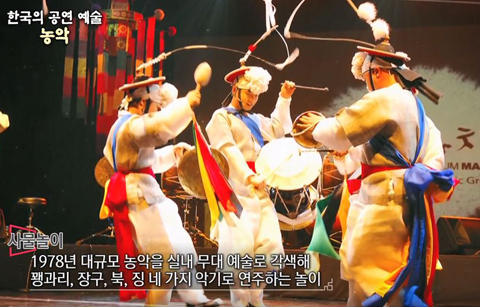 상세보기
상세보기Korean performing art Nongak (한국의 공연 예술, 농악)
해외문화홍보원과 한국문화재재단 문화유산채널이 협업하여 제작한 영상입니다.Korea, an agrarian society농경사회 한국'Us' more than 'me' ‘나’보다 ‘우리’The development of communal sentiment 공동체 의식 발달Nongak, the culture of an agrarian society농경사회의 문화Nongak농악Music and dance,음악과 춤Arts, marching, and so on기예, 행진 등The basis of Nongak농악의 기본Begins from communal sentiment공동체 의식에서 출발Nongak is defined as exciting traditional music performed by farmers with a communal sentiment농악이란 것은 농사를 지으며 힘든 부분을 풀어내기 위한 것으로[인터뷰] Jo Han-Suk / National Intangible Cultural Asset No. 11-2 Transmission Education Assistant for Pyoungraek Nongak조한숙 / 국가무형문화재 제11-2호·평택농악 전수교육조교which rose and developed while resting from the tough farming work as well as a form of prayer asking for rich harvest.Nongak is a traditional performance art.신명나는 악기 연주로 풍년을 기원하고 공동체 의식을 가짐으로써 화합하고 놀이를 하는 전통 예술이라고 볼 수 있습니다Samulnori is a performance using a small gong, janggu, drum and gongjing that is adapted from Nongak and involves a big group for theatrical arts in 1978. 사물놀이1978년 대규모 농악을 실내 무대 예술로 각색해 꽹과리, 장구, 북, 징 네 가지 악기로 연주하는 놀이Nongak was used to take a break from tough farming work and to pray for rich crops.농사일의 피로를 풀고 풍년을 기원하는 농악Nongak is a form of play and ancestral ceremony농경사회의 놀이이자 제사 의식The meaning of the musical instruments?농악에 사용되는 악기에 담긴 의미는?Small gongs symbolizes thunder꽹과리는 천둥, 번개를 의미Drum symbolizes land and cloud.북은 땅, 구름을 의미Janggu symbolizes rain.장구는 비를 의미Gongjing symbolizes wind.징은 바람을 의미Conductor is crucial for orchestrated harmony조화로운 연주를 위해 꼭 필요한 지휘자The Sangsoe of Nongak is equivalent to a conductor in western music서양 음악의 지휘자 = 농악의 상쇠 Sangsoe is the small gong musician that leads the group상쇠농악대 꽹과리 연주자중 우두머리A large scale of Nongak band is conducted by the Sangsoe상쇠의 신호에 따라 움직이는 대규모 농악대Performers, flag holders, and dancers are all under the command of the Sangsoe.농악수, 기수, 무용수 등 상쇠의 지휘에 따름Personal solos stand out in western music개인의 기량이 돋보이는 서양 음악의 솔리스트Nongak also has solo performances for demonstrating skill.농악에도 독무 부분 존재Beokkunori plays the Beokku, a drum-like instrument of Nongak 버꾸놀이농악기의 하나인 버꾸를 연주하며 기예를 선보이는 놀이Beokkunori spins the round flat discs such as dishes, bowls and buckets using a long stick.버나놀이접시, 대접, 대야 등 둥글납작한 것을 긴 막대기 끝에서 돌리는 놀이Performance are sometimes in solo, sometimes in unison독무 혹은 군무로 공연에 따라 다른 형태Nongak that shows the skills and spirit of the people through energetic beats신나는 장단에 맞춰 다양한 기예를 선보이는 농악[인터뷰] Jo Han-Suk / National Intangible Cultural Asset No. 11-2 Transmission Education Assistant for Pyoungraek Nongak조한숙 / 국가무형문화재 제11-2호·평택농악 전수교육조교The unique part of Pyeongtaek Nongak is that we have the mudeoungnori, not found in other nongaks.평택 농악은 다른 지역에 없는 무동놀이가 백미라고 할 수 있습니다Mudongnori: performance where a young boy/girl dancer performs on the shoulders of an adult무동놀이어린 무용수인 무동들이 어른의 어깨 위에 올라서서 춤을 추는 놀이In Mudongnori, the moves vary on the number of adults and the children’s dances and their moving formation무동놀이올라선 어른의 숫자, 무동이 추는 안무 움직이는 대형에 따라 춤의 이름이 달라진다A mudong may be more than three meters high.무동이 올라선 높이 최고 3미터 이상The arts of Pyoungtaek Nongak are heartwrenching and exciting아슬아슬하고 놀라운 평택농악의 기예A Korean National Intangible Cultural Asset and World Intangible Cultural Heritage.한국의 국가무형문화재 세계 인류무형문화유산 지정Nongak is a valuable cultural heritage.소중한 문화유산 농악Modernized farming methods and weakened community sentiment현대화된 농업방식 약화된 공동체 의식The role of Nongak as ancestral rites has substantially decreased제사로서의 농악역할 축소Nongak is loved by many as a composite performance arts 춤과 음악, 연기, 기예 등이 하나로...in which dance, music, performance and arts gather together종합 공연 예술로 사랑받는 현대의 농악 2017.12.28 -
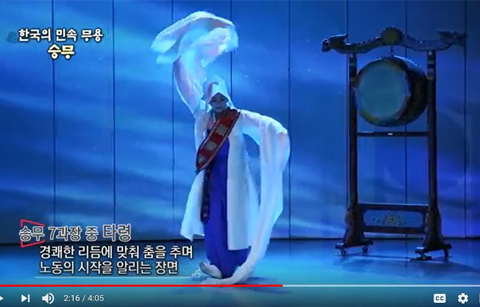 상세보기
상세보기Korean religious folk dance Seungmu (한국 무용의 꽃, 승무)
해외문화홍보원과 한국문화재재단 문화유산채널이 협업하여 제작한 영상입니다.the countless Korean traditional dances that have been passed down through generations전해 내려오는 수많은 한국의 전통 춤the fluid connection of movements with no pause in between정지 상태 없이 동작과 동작이 연결a traditional dance in its true art form, Seungmu예술성 높은 전통 춤 승무 The Hwangjini Theory of Originthe idea that the dance was first performed by a hostess named Jini Hwang in an attempt to spoil Jijok the great monk.<승무> 황진이 유래설면벽수행하던 지족선사를 파계하려 조선의 기생 황진이가 춘 춤에서 유래됐다는 설[인터뷰] Yang Seo-Yun / Important Intangible Cultural Asset No. 27 Seungmu-master 양서윤 / 국가무형문화재 제27호 승무 이수자The Talchum, Nojang Gwajang theory of originA Talchum(mask dance) about an old Buddhist monk, who is seduced by a woman and eventually becomes an apostate.<승무> 탈춤 노장과장 유래설오래 수행한 승려가 여자에 미혹되어 파계하는 내용인 탈춤의 노장과장에서 유래됐다는 설though the origins are unclear, it is a dance that involves wearing the monk outfit시작은 분명하지 않지만 승복을 입고 추는 춤Originating from a Buddhist ceremony is the most probable theory of origin불교 의식에서 유래됐다는 설이 유력a beautiful dance that arose from combining Buddhism with art불교와 예술이 만나 아름답게 피어난 승무Fluid choreography from start to finish, the Seungmu시작부터 끝까지 물 흐르듯 이어지는 승무 안무Choreography that summarizes human birth and the process of achieving nirvana태어날 때부터 해탈하기까지 인간의 삶을 축소Gwajangone scene depicted from Korean traditional dance과장한국 전통춤에서 한 장면을 이르는 말[인터뷰] Yang Seo-Yun / Important Intangible Cultural Asset No. 27 Seungmu-master 양서윤 / 국가무형문화재 제27호 승무 이수자It begins with the slow depiction of prayer, and then speeds up to depict what’s called the dangak.Even among our traditional dances, the Seungmu has the most “ups and downs” melted within the choreography.느린 장단인 염불에서 시작해서 빠른 당악까지고조를 오르내리는 춤이기 때문에한국 전통 무용과 마찬가지로승무도 희로애락을 많이 드러낸 춤입니다“Prayer” from the 7 scenes of Seungmu a depiction of the birth of the universe and the inception of life승무7과장 중 염불우주의 탄생과 생명의 씨앗이 잉태돼 태어나는 시작을 알리는 장면“Dodeuri” from the 7 scenes of Seungmuthe scene connecting taryeong with prayer승무7과장 중 도드리타령과장으로 넘어가는 염불과 타령의 연결 장면“Taryeong” from the 7 scenes of Seungmua depiction of the beginning of manual labor against the backdrop of exciting rhythm and dance승무7과장 중 타령경쾌한 리듬에 맞춰 춤을 추며 노동의 시작을 알리는 장면“Gutgeori” from the 7 scenes of Seungmua depiction of joy sorrow illness and health and other various emotions승무7과장 중 굿거리생로병사, 희로애락 등 살아가면서 느끼는 다양한 감정을 표현하는 장면“Buk” from the 7 scenes of Seungmuconnecting towards the dangak using the drum승무7과장 중 북춤꾼이 직접 북채로 북을 치며 당악으로 이어나가는 장면Samhyeonyukgwak an ensemble of traditional Korean music that includes a flute, jeotdae, haegeum, drum, and janggu삼현육각한국 전통음악의 악기 편성법으로 향피리, 젓대, 해금, 북, 장구 사용[인터뷰] Yang Seo-Yun / Important Intangible Cultural Asset No. 27 Seungmu-master 양서윤 / 국가무형문화재 제27호 승무 이수자We hope that you were able to experience and feel the traditional Korean emotion, color, rhythm,and detailed movements embodied within, as expressed by the dancer.승무를 관람하시는 모든 분들이한국적인 정서, 색채, 리듬과음악적인 부분, 무용수의 움직임을 통해서많은 감흥과 감동을 느끼실 수 있었으면 좋겠습니다 2017.12.27 -
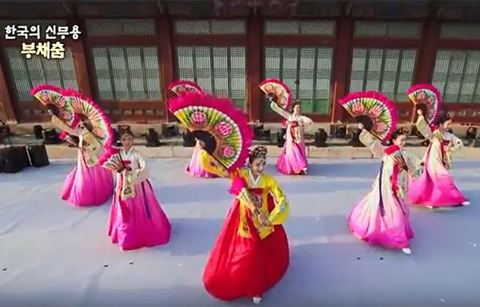 상세보기
상세보기Korean New dance The fan dance (한국의 신무용, 부채춤)
해외문화홍보원과 한국문화재재단 문화유산채널이 협업하여 제작한 영상입니다.a performing arts dancer on stage using a fan무대 위를 누비는 부채 든 여성 무용수Beautiful and colorful hanbok화려함을 더하는 한복이나 당의the elegant dance moves where the fan, hands, and feet all move as one부채, 손, 발이 하나가 된 다채로운 춤사위the graceful and fluid movement of the fan물 흐르듯 움직이는 부채의 아름다움The harmonized movement with fellow dancers곁에 선 무용수와의 연결 동작A beautiful flower in movement created using fans대형과 부채의 움직임에 피어나는 꽃과 물결A combination of calm graceful movements and active movements차분한 동작과 역동적인 동작의 조화[인터뷰] Lee Jeong-Min / Member of Direction Committee, Korea Cultural Heritage Foundation 이정민 / 한국문화재재단 예술단 지도위원The Fan Dance was created originally as a solo dance. it was first performed by Baek-bong Kim, a choreographer for the Seoul Metropolitan Residence on Novermber 26, 1954.It depicts the restrained beauty, elegance, and the dignified lines of women. It also depicts the good balance of yin and yang.부채춤은 김백봉 무용가에 의해 1954년 11월 26일서울시 시공관에서 독무로 창작돼 발표됐던 신무용입니다.여성의 절제미, 우아함, 중후한 선을 표현한 춤이고더 나아가 음양의 조화가 잘 이뤄진 춤입니다.Based on traditional Korean dance movements한국 전통 춤이 기본dance with origins in solo performance during the 1950s 1950년대 창작된 독무1968, the first time numerous dancers performed무용수 단체가 선보인 것은 1968년의 일World Folk Art Festival, Olympic Games in Mexicothe fan dance was reinterpreted using a group of dancers instead of one68 멕시코올림픽과 병행된세계민속예술제전독무를 군무로 재구성해무대에 오른 부채춤The wind draft created by the fan and the skirt-tails of the dancers부채와 무용수의 치맛자락이 일으키는 바람out stretching the arm to express big refreshing movement팔을 길게 뻗어 시원하고 큰 동작을 표현Many fans connecting to form flower petals 여러 개의 부채가 꽃잎처럼 화사하게...use of round the smooth movements instead of sharp angles각지고 딱딱한 동작 대신 둥글고 부드럽게 흐르는 부채춤the flow of the fans create a sense of flower petals fluttering in the wind바람에 흩날리는 꽃잎을 떠올리게 하는 부채 물결choreography that looks different from every angle앞, 뒤, 옆, 위 사방에서 다르게 보이는 안무folding and unfolding the fan is the basic of this dance부채를 펴고 접는 기술은 기본The fan dance involves creating graceful arcs and lines using the fan and the arm부채를 든 팔의 움직임으로 춤 선을 만들어 내는 부채춤the fan becomes one with the dancer무용수와 하나 돼 움직이는 부채completing the gracefulness of the fan dance부채춤의 아름다움을 완성하는 척도[인터뷰] Lee Jeong-Min / Member of Direction Committee Korea Cultural Heritage Foundation이정민 / 한국문화재재단 예술단 지도위원The defining action of the dance is hitting the knee and unfolding the fan.대표적 동작은 ‘무릎쳐펴기’인데요무릎을 쳐서 부채를 펴는 동작입니다.It’s where the arm is drawn up,또 다른 것은 끌어올리기 동작이 있는데요.such as when expressing the movement of a wave or flowers. That graceful movement is the defining part of the entire fan dance.파도, 꽃물결을 만들 때 부채를 끌어올리는 부분으로 이 동작들이 가장 대표적입니다.fans are used for the mask dance, tight rope walking, and pansori 탈춤, 줄타기, 판소리 등 공연 소품으로 사용된 부채the variety of characters that dance to the beat and created exaggerated sceneries장면을 극적으로 만들고 장단을 맞추는 등 다양한 역할the fan, once only a prop and now the main centerpiece소품이던 부채의 화려한 변신once a prop, and now the main character소품에서 무대의 주인공이 된 부채the representative performing arts showcasing the beauty of Korean traditions한국 전통미를 보여주는 대표적인 공연 예술the fan dance appeals to the eyes with the use of the fan and colorful costumes한복과 화려한 부채로 시선을 끄는 부채춤a living artform that is continuously adapting and evolving with the changing Times제자리에 머무는 것이 아닌 끊임없는 변화하는 살아있는 예술the shape of the fan, and the reinterpretation and expression of dance의상과 부채의 형태, 안무의 재해석과 재구성Modern Korean dance that melds the past and the present flawlessly부채춤 전통과 현재가 어우러진 한국의 신무용 2017.12.27 -
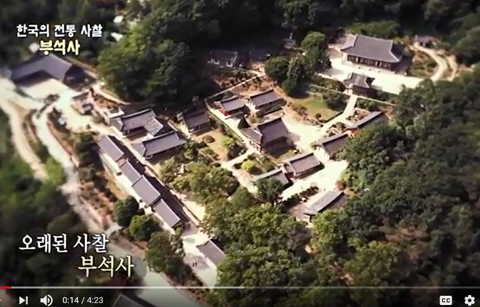 상세보기
상세보기Korean traditional temple Buseoksa (한국의 전통산사, 부석사)
해외문화홍보원과 한국문화재재단 문화유산채널이 협업하여 제작한 영상입니다.Buseok-myun, Youngju-shi, Gyoungsangbuk-do경상북도 영주시 부석면A thousand year old temple 오래된 사찰 부석사Most Korean temples are built deep within mountains대부분 산 속에 지어진 한국의 사찰Buseoksa is located on the mid-slope of Bonghwang Mountain.봉황산 중턱에 자리잡은 부석사The base of Hwaeomgyo, one of the many Buddhist sects in Korea화엄사상을 중심으로 한 화엄교의 본거지Buseoksa is where Uisang the Great Monk educated his students신라시대 의상대사가 제자를 기르고 수행하던 곳Built in 676 A.D. during the Shilla Dynasty, 1300 years ago1,300여년 전인 676년 신라시대에 지어진 부석사Buseoksa developed alongside the history of Korean Buddhism한국의 불교 역사와 함께 성장The present figure is a result of time lapsed construction through many generations여러 세대를 거쳐 지금의 모습으로...Buseoksa is in good harmony with each of its structures and with the surrounding topography주변 지형과 조화를 이루는 부석사의 풍경Iljumun: the starting gate to the temple with two pillars built in a straight line.일주문사찰에 들어가는 첫 번째 문으로 두 개의 기둥이 일직선에 있어 일주문이라 부른다The boundary dividing this world with Buddhist areas 인간이 사는 속세와 불교의 세상을 나누는 경계선Buseoksa takes great pride in its dense ginkgo tree forest 부석사의 자랑은 울창한 은행나무숲Cheonwangmun: the gate where four heavenly guardians defend the temple 천왕문불교의 정토(천국)를 지키는 네 명의 천왕이 지키고 있는 곳으로 문처럼 통과하는 구조의 건물A total of 108 stairways 사찰의 내부로 가는 108개의 계단108 earthly anguishes resolved and a step closer to nirvana마음의 갈등을 뜻하는 108 번뇌와 계단을 오르며 얻는 깨우침The signboard of Muryangsujeon Hall through the stone lantern.석등 사이로 보이는 무량수전의 현판Muryangsujeon Hall: a one-storied wooden building designated as National Treasure No. 18단층 목조 건물인 국보 제18호 무량수전Seated Amitabha Buddha, designated as National Treasure No. 45. in Muryangsujeon Hall. 무량수전 안 불상 국보 제 45호 소조아미타여래좌상Muryangsubul, with wisdom and infinite life지혜와 무한한 생명을 가진 무량수불The building Muryangsubul exists referred to as Muryangsujeon Hall.무량수불이 있는 건물 = 무량수 + 전Muryangsujeon Hall was built during the Goryeo Dynasty무량수전은 고려 때 지어진 건물로 [인터뷰] Kim Chae-Su / Cultural Tourism Interpreter, Youngju-shi, Gyoungsangbuk-do김채수 / 경상북도 영주시 문화관광해설사Muryangsujeon Hall was built during the Goryeo Dynasty, and it is said to be the most beautiful wooden architecture in Korea.목조 건축물로 우리 한국에서 가장 아름다운 미를 가지고 있는 건물이라고 할 수 있습니다What is special about the architectural style of Muryangsujeon Hall?무량수전의 특별한 건축양식은?[인터뷰] Kim Chae-Su / Cultural Tourism Interpreter, Youngju-shi, Gyoungsangbuk-do김채수 / 경상북도 영주시 문화관광해설사Muryangsujeon Hall can be summarized into two characteristics. First, it was built to take shape of the foothills of Taebaek and Bonghwangsan Mountains, and as such uses a beautiful arc representative of Korean architecture to hold the roof. 무량수전의 (건축 양식은) 두 가지로 요약할 수 있는데요 봉황산 산기슭과 태백,소백산맥의 안허리 곡선이라는 가장 한국적인 미를 창출하는 선으로건물의 (지붕이) 지어졌다는 것입니다And if you take a look at the pillars the middle area is wide while the upper and lower parts are narrow,풍경과 조화를 이루는 무량수전의 지붕, and this is called the Baeheullim pillar. This architectural form at its great load strength which is needed to uphold the immense weight of the roof.기둥을 보면 배 부분이 가장 부르고 위아래가 좁아지는 형태로 배흘림기둥이라고 합니다. 내부 부재의 힘을 주추로 받아 내리기 위한 형태입니다North of Muryangsujeon Hall, the Josadang Shrine National Treasure No. 19. 무량수전 북쪽 국보 제19호 조사당Front of Josadang Shrine, a tree named 'Seonbihwa' 조사당 앞 푸른 잎의 선비화The legend related to Uisang the Great Monk, the founder of Buseoksa.부석사를 지은 의상대사와 관련된 전설"After I die, branch and leaf will grow on my walking stick. Unless this tree withers to death, I won't die." -, a geography book of Joseon Dynasty “내가 떠난 뒤 지팡이에서 반드시 가지와 잎이 날 것이다. 이 나무가 말라죽지 않으면 내가 죽지 않으리라“ - 조선시대 지리서 <택리지> 중 -Meet the history of Korean Buddhism, a traditional style of architecture and a variety of cultural properties altogether at Buseoksa, a beautiful Korean traditional temple한국 불교의 역사, 전통 건축 양식, 다양한 문화재 Buseoksa, a beautiful Korean traditional temple아름다운 한국의 전통 사찰, 부석사 2017.12.26 -
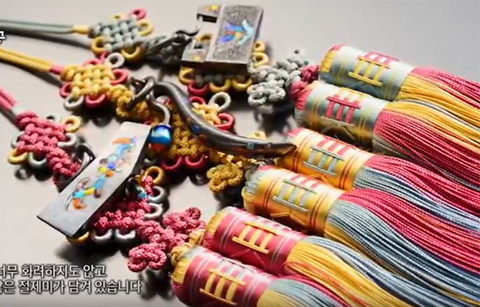 상세보기
상세보기한국의 장신구, 전통 매듭
해외문화홍보원과 한국문화재재단 문화유산채널이 협업하여 제작한 영상입니다.[자막] 여성의 몸치장에 쓰인 아름다운 장신구 노리개Norigae: and accessory used to complete a woman’s wardrobe매듭에서 나오는 노리개의 아름다움과 화려함The elaborate beauty of the norigae using knots화려한 아름다움 중국 매듭elaborate beauty Chinese knot단순하고 실용적인 일본 매듭simple but practical Japanese knot[인터뷰] 박선경 / 국가무형문화재 제22호, 매듭장 전수교육조교 Park Seon-Kyoung / Important Intangible Cultural Asset No. 22, Transmission Education Assistant for Medupjang (Knot-master) 한국 매듭은 너무 화려하지도 않고단순하지도 않은 절제미가 담겨 있습니다The Korean knot isn’t elaborate nor is it overly simple;다른 나라에 비해 실생활에서도(한국의 전통 매듭은) 다양하게 쓰입니다it expresses a sense of restraint, and compared to other countries, it’s used more in frequency.[자막] 멋과 기품을 더해주던 장식 예술decorative art that added style and elegance염색 과정매듭의 주재료 명주실The dyeing processMyeongjusil: the May material used for braiding knots염색 과정정성이 필요한 명주실 염색 작업The dyeing processMyeongjusil silk that requires meticulous dedication when dyeing[인터뷰] 박선경 / 국가무형문화재 제22호, 매듭장 전수교육조교Park Seon-Kyoung / Important Intangible Cultural Asset No. 22, Transmission Education Assistant for Medupjang (Knot-master) 명주실 염색은 자연 염료를 사용하고 있으며 붉은색은 홍화나 소목 등으로 염색을 하고Natural dyes are used to color the silk: safflower and sappan wood for red,청색이나 녹색은 쪽으로 염색을 하며 노랑은 치자 등으로 염색을 합니다indigo for blue/green, and gardenia for yellow.이렇게 자연 식물에서 다양한 색상을 얻고 있습니다There are a wide variety of colors available when using natural plants.[자막] 다회치기 과정염색한 실을 감은 토짝Dahoechigi (braid-hitting) ProcessSpool used for winding the silk thread다회치기 과정토짝을 매달아 끈을 짜는 다회틀Dahoechigi (braid-hitting) ProcessSpinning yarn from silk using the dahoeteul다회치기 과정실을 엮는 것(발생)= 하늘과 땅을 엮는 것Dahoechigi (braid-hitting) Processbraiding the heavens and the earth together다회치기 과정매듭의 용도와 크기에 따라 달라지는 끈목의 굵기Dahoechigi (braid-hitting) Processsilk threads are spun into varying thicknesses depending on use and size of the knot다회치기 과정매듭장의 실력이 드러나는 토짝 부딪히는 소리Dahoechigi (braid-hitting) Process speed and steadiness of the “bump” tells the skill of the master수십 가지 모양의 한국 전통 매듭dozens of variations for the Korean traditional knot한국 매듭은 끈목을 반으로 접어 시작하며 중심에서 시작과 끝이 맺어지고 앞뒤 좌우 대칭이 됩니다Making a Korean knot begins by folding the woven yarn in half and the centerpoint from where the knot will go left, right, up, or down.[인터뷰] 박선경 / 국가무형문화재 제22호, 매듭장 전수교육조교 Park Seon-Kyoung / Important Intangible Cultural Asset No. 22, Transmission Education Assistant for Medupjang (Knot-master) 또한 매듭의 명칭은 연봉매듭, 국화매듭, 매화매듭, 매미매듭 등으로Some of the knots have names, such as the lotus knot, chrysanthemum knot, plum blossom knot, and the cicada knot.주변에서 볼 수 있는 꽃과 곤충의 이름을 딴 것들이 많아 (모양과 이름에서) 친근함이 느껴집니다These knots are named after things found in nature such as plants or animals and give a sense of familiarity for us.[자막] 모양에 따라 결정되는 매듭의 이름name of the not determined by its shape국화매듭 행운과 신변 보호Chrysanthemum Knotsymbolizes luck and protection나비매듭부부의 화합, 다산, 장수Butterfly Knotsymbolizes marriage harmony, multiple births, and longevity동심결매듭영원Childhood Knotsymbolizes eternity술 만들기매듭의 완성도를 높이는 술 장식Making the tasseltassels complete the look of the knot술 만들기실을 풍성하게 꼬아 만드는 술Making the tasselbraiding threads to look abundant술 만들기가지런히 정리한 색색의 실Making the tasseldifferent colored thread organized neatly술 만들기술의 형태에 따라 마무리 후 매듭과 연결Making the tasselConnecting the tassel to the knot depending on the shape한국의 선조들은 매듭을 장신구로 사용하여(몸치장을 할 때) 멋과 기품을 더하였습니다Our ancestors in the past used knots as accessories which added color to their lives and the meaning of the knots added much charm to their daily life.생활 소품과 매듭의 만남 아름다워진 일상용품The knot combined with everyday items to add beauty장엄함을 더해주는 의례와 종교용 매듭Knots that adds grace and purpose to be used for ceremonial occasions[인터뷰] 박선경 / 국가무형문화재 제22호, 매듭장 전수교육조교 Park Seon-Kyoung / Important Intangible Cultural Asset No. 22, Transmission Education Assistant for Medupjang (Knot-master) 예전에 비해 매듭의 쓰임새는 많이 줄어들었으나 매듭이 갖고 있는 아름다움을Even though we don’t use the knots as much as before, it certainly does add beauty to our lives,많은 사람들에게 알릴 수 있도록 발전해 나가야겠습니다and we need to share with better with the world.[자막] 한국인의 생활 속 매듭의 쓰임새the use of knots in everyday Korean life한국의 매듭다양한 색과 모양이 만든 전통 장식 예술The Korean knota traditional art form of various colors and shapes used for decoration 2017.12.20 -
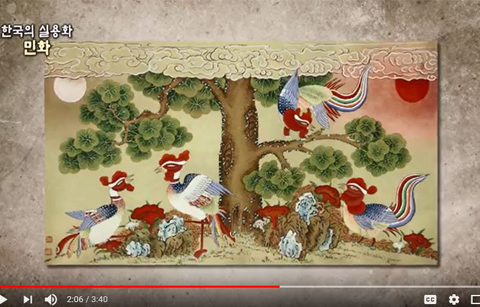 상세보기
상세보기Korean folk painting Minhwa(한국의 전통그림, 민화)
해외문화홍보원과 한국문화재재단 문화유산채널이 협업하여 제작한 영상입니다.[자막] 예술의 주요 장르 그림the most representative genres in art: paintings일상에서 쉽게 접하는 한국 전통 그림 민화easily found in daily lifeKorea’s traditional painting, minhwa[인터뷰] 정귀자 / 서울시 무형문화재 제18호, 민화장 전수교육조교Jung Gui-Ja / Seoul Intangible Cultural Asset No. 18, Transmission Education Assistant for Minhwajang 이 그림은 작호도이며 풀이하자면 까치와 호랑이 그림입니다 This is called “Jakhodo” and the title simply means, “The Magpie and Tiger Painting.”[자막] 반가운 손님좋은 소식의 상징 까치Magpies, symbols of good news and welcome guests 용맹하여 악귀를 막는 수호신 호랑이Tigers, protectorate from evil through their courage작호도 좋은 소식은 부르고 악운은 막기를 바라는 마음을 담은 그림Jakhodothe painting that embodies the aspiration of good news and protection from evil풍경, 동식물, 생활상 등 다양한 주제scenery, animals, plants, everyday life, and many more themes단순한 표현돋보이는 실용화simple in expressionpracticality in purpose강황, 쑥, 자초, 등황, 치자tumeric, mugwort, jacho, cambogia, and gardenia자연재료로 표현하는 전통적인 오방색The five cardinal colors derived from natural materials지배계층의 전유물 문인화Paintings owned by the ruling classMuninhwa서민의 정서가 담긴 민화paintings that embody the common people’s spirit Minhwa장식 장소와 용도 따라 그림의 주제 변화themes differ depending on location and use한국인 정신세계 속 상징들이 그림 속으로...the essence of Korean mentality captured in painting선명하고 강렬한 민화의 색채와 화법minhwa’s use of bold strokes and vibrant colors민간 신앙과 결합한 주술적 역할a fusion of religious beliefs in order to act as a talisman우스꽝스럽게 표현된 민화 속 호랑이minhwa portraying the tiger in a humorous light해학과 풍자를 통한 재해석이 민화의 매력reinterpretation through humor and satire is the appeal of minhwas민화가 시작된 혼란의 시대 조선 후기minhwa began appearing during Joseon Dynasty’s tumultuous 정식 교육을 받지 않은 수많은 무명 화가들countless unnamed artists with no formal education[인터뷰] 정귀자 / 서울시 무형문화재 제18호, 민화장 전수교육조교민화는 일반 서민의 삶의 담은 자유로운 기법의 그림입니다Jung Gui-Ja / Seoul Intangible Cultural Asset No. 18, Transmission Education Assistant for Minhwajang Minhwa is a freestyle painting that drew upon the lives of the common people.민중의 행복과 애환을 고스란히 담고 있습니다It embodies the happiness, joy and sorrow of them all.[자막] 연화도불교의 상징인 연꽃Yeonhwado (Lotus Flower)the lotus flower symbolizes Buddhism책가도책과 문방사우 등Chaekgado (Bookshelf)books, stationary, and writing utensils어해도잉어, 메기 등 물속 생물Eohaedo (Fish)underwater creatures including goldfish and catfish화조도각종 꽃과 새Hwajodo (Flowers and Birds)various types of flowers and birds정통회화를 모방해 특색 있는 그림으로 발전Imitating traditional painting techniques to create an entirely new and unique painting style민중이 그리고 전파한 민화Art form that spread among the common people한 장의 그림으로 생활공간을 장식Simple painting that illuminates and decorates living spaces왕실까지 전파된 민화의 매력the appeal of minhwa reaches the royal court서민 문화를 넘어 지배계층의 문화로까지...from art of the common people to becoming a culture for the ruling class관혼상제에 사용되는 병풍생활 소품에 여전히 등장Used in folding screens and other household items used for ceremonial occasions[인터뷰] 정귀자 / 서울시 무형문화재 제18호, 민화장 전수교육조교 Jung Gui-Ja / Seoul Intangible Cultural Asset No. 18, Transmission Education Assistant for Minhwajang 예전에는 민화가 베껴 그린 그림으로 치부됐지만요즘은 뛰어난 해학미, 소박함, 파격적인 구성으로많은 사랑을 받고 있습니다[자막] 외적의 침입 등의 혼란 그림으로 극복하려는 민심overcoming the tribulations of foreign invasion through painting민중의 마음이 담긴 실용화 민화practical art that embodies the spirit and mentality of the people 2017.12.20 -
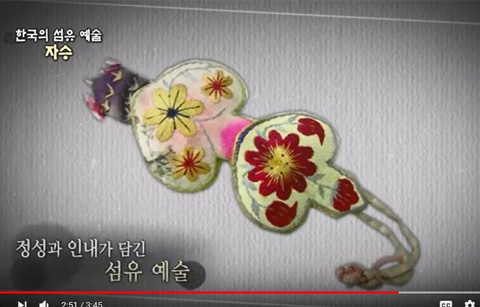 상세보기
상세보기Korean textile art Jasu (한국의 섬유예술, 자수)
해외문화홍보원과 한국문화재재단 문화유산채널이 협업하여 제작한 영상입니다.A branch of bamboo stretched out in blue. 푸르게 뻗은 대나무 가지최유현 作 <왕대>The beauty of Jasu is vividly shining through 실의 결이 살아있는 자수Susan-ri Tomb Mural Painting, Goguryeo고구려 수산리 고분벽화It’s assumed that the history of jasu dates back to around or before the age of the three kingdoms in that a related record has been discovered and some of the figures that are embroidered in the cloth have been found in mural paintings.자수의 역사는 삼국시대부터 기록이 발견됩니다 벽화를 보면 수를 놓은 옷을 입었다는 것이 나오는데요Anaki Tomb Mural Painting No. 3, Goguryo 고구려 안악 3호분 벽화It’s assumed that the history of jasu dates back to around or before the age of the three kingdoms in that a related record has been discovered and some of the figures that are embroidered in the cloth have been found in mural paintings. 자수의 역사는 삼국시대부터 기록이 발견됩니다 벽화를 보면 수를 놓은 옷을 입었다는 것이 나오는데요 [인터뷰] Choi Yu-Hyeon / National Intangible Cultural Asset No. 80 Jasujang(Embroidery)최유현 / 국가무형문화재 제80호 자수장 보유자It's assumed that history of Jasu dates back before the age of three kingdoms 삼국시대 그 이전부터 자수를 하지 않았느냐 그렇게 생각하고 있습니다Only works of Post-Joseon Age exist considering the characteristics of textile arts 섬유 예술의 특성상 조선시대 이후 작품만 현존하는 자수It's assumed that Korean Jasu began during the pre-historic age선사시대로 추정되는 자수의 시작 시기Any piece of fabric can be embroidered with only a needle and thread실과 바늘로 헝겊을 장식Jasu has developed alongside the development of textiles직물의 발달과 함께 한 자수의 역사Jasu includes themes such as animals, plants, calligraphy, and landscape, and so on동물, 식물, 문자, 풍경 등 다양한 자수의 소재Jasu depicts familiar items around us주변에서 쉽게 보는 익숙한 대상을 표현Jasu is beautiful and splendid using colorful threads색색의 실을 사용한 아름답고 화려한 자수Jasu is widely used in clothing, interior accessories and other necessities장식품, 생활용품에 두루 활용Upon making a rough sketch on a fabric and hanging it onto a mold with a fake-fabric attached, we make a Jasu on such a sketch.(자수는) 직물에 밑그림을 그리고 다른 직물을 덧대서 수틀에 매고 밑그림 위에 수를 놓게 됩니다There are dozens of Jasu(embroidery) methods according to the thickness and twist of threads. 실의 굵기와 꼬임에 따라 수십 가지에 이르는 자수 기법Linking Jasu making line 선을 만드는 이음수Flat Jasu for façades면을 채워나가는 평수Knot Jasu expressing stamens of flowers꽃 술 등을 표현하는 매듭수A variety of methods used according to its expression.표현법에 따라 다양한 기법을 활용 2017.12.19Painted by Choi Yu-Hyeon최유현 作 <주작>[인터뷰] Choi Yu-Hyeon / National Intangible Cultural Asset No. 80 Jasujang(Embroidery)최유현 / 국가무형문화재 제80호 자수장 보유자We can generally divide Jasu into four parts: religious, living, decorative, and clothing dress.크게 나누면 네 가지입니다 (발생)종교자수, 생활자수, 장식자수, 복식자수입니다Buddha painting or Buddhist scriptures are the main themes of Religious Jasu불화나 불경을 소재로 한 한국 전통 종교 자수 Korea was dominated by Buddhism 불교문화권인 한국Jasu is thought to be a method of fulfillment or dedication자수를 수행과 공양 방법의 하나로 인식Painting or lettering enhances the artistic value of folding screen병풍의 예술적 가치를 높이는 그림과 글씨Jasu portrays the pattern which decorates folding screens병풍을 장식할 문양을 그려내는 자수의 예술성Interior decorating goods such as wardrobe장롱 등의 실내장식품Minor living properties such as accessories, pockets, thimbles, and so on장신구, 주머니, 골무 등 생활 소품Jasu is widely used as an accessory in every corner of korean daily life.생활 곳곳에 다양하게 사용된 장식으로서의 자수Threads and needles adds color vivid depth실과 바늘로 살리는 색과 입체감Jasu is textile arts that requires sincerity, as well as patience.정성과 인내가 담긴 섬유 예술We used to think this was only a woman’s pastime in the olden days, but it’s not anymore. Jasu is now being highly appreciated in foreign countries(우리나라에서는) 옛날 여성들이 가정에서 시간이 남을 때 꿰매는 것, 장난삼아서 하는 것이 자수라 여겨졌는데 (외국에서는) 한국 자수의 평가가 대단히 높게 평가받고 있습니다[인터뷰] Choi Yu-Hyeon / National Intangible Cultural Asset No. 80 Jasujang(Embroidery)최유현 / 국가무형문화재 제80호 자수장 보유자Jasu has been highly appreciated in that there exists an unique aesthetic world that can be implemented by Jasu only.자수만이 할 수 있는 미적인 세계를 살리기 때문에 한국의 자수가 평가를 높이 받습니다Jasu originally started from the desire to decorate things beautifully. 아름답게 꾸미려는 장식으로서 시작된 자수Jasu is used in every corner of Korean daily life. 한국인의 생활 곳곳에 활용Jasu is a textile art that adds beauty and charm to Korean life.생활에 아름다움과 멋을 더하는 섬유예술 자수 -
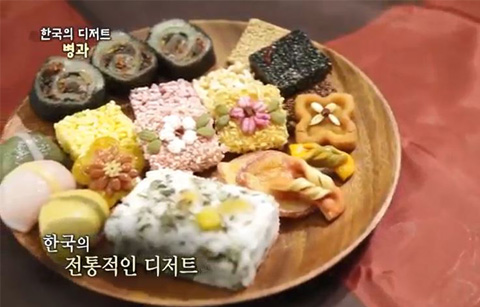 상세보기
상세보기Korean traditional dessert Byeonggwa (한국의 디저트, 병과)
해외문화홍보원과 한국문화재재단 문화유산채널이 협업하여 제작한 영상입니다.[자막] 단단한 나무틀에 새겨진 무늬 Hardened wood slats with patterns이 나무틀은 무엇에 쓰는 물건? The use for these slats?중국의 전통차와 어울리는 월병Weolbyeong and traditional Chinese tea각종 차와 함께 즐기는 다양한 디저트Various desserts for various teas한국의 전통적인 디저트Korea’s traditional dessert연회,제례 등 각종 행사 상차림에 필수A must for celebrations and ceremonies한국인의 삶과 밀접한 병과Close to the lives of Koreans, byeonggwa한국의 디저트는 과연 무엇?What are Korea’s desserts?한국의 떡을 뜻하는 병(餠)한국의 과자를 뜻하는 과(菓)byeong = Korean rice cakegwa = Korean cookie[인터뷰] 박영미 / 국가중요무형문화재38호, 조선왕조 궁중음식 기능 이수자Park Youngmi / Important Intangible Cultural Asset No. 38, Master of Royal Culinary Art of Joseon Dynasty병과(餠菓)란?한국의 떡과 과자를 뜻합니다What is byeonggwa?It means, “Korean rice cakes and cookies”잣설기Jatseolgi잣설기의 재료Jatseolgi ingredients잣설기 만드는 법①멥쌀가루에 물과 꿀을 섞어 잘 비빈 뒤, 중간체에 내린다②섞인 가루에 잣가루와 설탕을 넣고 섞는다곡물에 견과류, 과일, 꽃가루 등을 더한 한국의 전통 병과To make Jatseolgi:1. Mix rice flour, water and honey well and sift it in mid-sized sieve.2. Add ground pine nuts and sugar to the rice powder and mix well.How to cook Jatseolgi3. Put the rice flour mix into cooker (siru) and make some slits.4. When steam arises evenly, cook for another 20 min. and let it sit 5 min.나무틀의 용도는? The use of these slats?도구의 명칭은?떡살 또는 ‘떡을 찍는 손’이라고 해서 떡손이라고도 합니다The name of this tool?Tteoksal or Tteokson, because it is the hand (son) that forms the rice cake (tteok)장수, 복을 비는 떡살의 무늬Pattern symbolizing longevity and fortune다양한 무늬와 화려한 색감의 떡Various patterns in vibrant different colors단순한 디저트가 아닌 마음까지 담은 한국의 떡not just a dessert, but a piece of the heart as well약과Yakgwa약과의 재료YakgwaI ingredients약과라는 이름의 유래는?The etymology of yakgwa지방 섭취가 어려웠던 농경사회 한국Korea, an agrarian society in which the intake of fat was difficult“밀은 사시정기(四時精氣)요,꿀은 온갖 약의 으뜸이요,기름은 벌레를 죽이고 해독하기 때문“-조선시대 생활지침서 「규합총서」 중-Wheat is vital energy for all through the year,Honey is the best of all medicines,Oil kills worms and removes poison."- From Gyuhapchongseo, guideline for everyday life in Joseon Dynasty약과 만드는 법①밀가루에 소름과 후춧가루, 참기름을 넣어 고루 비벼 체에 내린다②참기름 섞은 밀가루에 꿀,생강즙,청주를 넣어 한데 넣고 반죽을 한다How to make Yakgwa:1. Mix flour, salt, ground black pepper and sesame oil well, and sift in a sieve.2. Add honey, ginger juice and rice wine to make dough.약과의 모양을 내기 위한 ‘다식판’Dasikpan: honey-cake board used for shaping Yakgwa약과 만드는 법③반죽을 떼어 다식판에 꼭꼭 눌러서 반죽의 모양을 잡아준다How to cook Yakgwa2. Take the dough and press into the honey-cake mold. 속까지 익을 수 있게 반죽에 구멍을 내어주는 과정Perforations on the dough to ensure even cooking기름 소리와 함께 익어가는 약이 되는 과자 “약과”The yakgwa is fried in sizzling oil into hearty treats 전체가 갈색이 되도록 천천히 튀겨내는 것이 중요The importance lies in ensuring they are slowly and evenly fried to a nice brown color식기 전 시럽에 담가 단맛을 입히는 마지막 과정The last process in which they are coated and syrup for a sweet taste before they are cooled달콤한 디저트이자 약이 되어준 전통 과자 Korea’s traditional cookie and sweet dessert with medicinal properties자극적이지 않은 달콤함을 가진 한과Hangwa, light but not overbearing sweets 우리나라의 병과는 따뜻한 전통차도 어울리지만수정과,식혜,오미자화채 등 시원한 음료도 잘 어울립니다Our hangwa goes well with a cup of hot tea, but it is also goes well with out cold beverages such as sujeongwa (persimmon drink), sikhye (rice drink), and omija (berry) punch.전통 음료뿐만 아니라 커피와도 잘 어울리는 한국의 병과A treat that goes well with not only traditional beverages the coffee as well, the Korean byeonggwa[인터뷰] 박영미 / 국가중요무형문화재38호, 조선왕조 궁중음식 기능 이수자 Park Young-Mi / Important Intangible Cultural Asset No. 38, Master of Royal Culinary Art of Joseon Dynasty한국의 훌륭한 전통 병과를 많은 외국인이 경험하고 맛을 체험하셨으면 좋겠습니다We hope that more foreigners we’ll be able to taste experience Korea’s outstanding traditional byeonggwa treats.[자막] 쌀이 주식인 나라의 쌀을 활용한 디저트 desserts made from rice from a country whose staple food is rice정성 담긴 음식으로 손님 대접에도 사용perfect for entertaining guests한국인의 삶과 밀접한 음식 병과Desserts that are close to the daily lives of all Koreans, the byeonggwa든든한 음식 병과는 시대에 맞춰 발전 중The hearty byeonggwa is evolving with the changing times보기 좋고, 먹기 좋은 디저트에서...From a dessert that looks good and tastes good…건강식으로 인정받은 한국의 전통 음식 병과to a nutritious healthy treat, Korea’s traditional food, the byeonggwa[인터뷰] 쌀로만든 음식을 좋아하시면 이건 확실히 좋아하실 겁니다. 스낵으로는 좋네요.계속먹고싶어요.If you like rice, you’re going to like this definitely. As a snack, it’s good. I can’t stop eating it.[자막] 다양하고 화려한 색다채로운 식감과 맛Diverse and vibrant colorsdiverse in taste and texture[인터뷰] 달고 식감이 좋네요.It’s sweet and texture is nice.[인터뷰] 맛있어요. 너무 좋아해요. 원래 한식을 좋아했어요.It was good food. I love it. I love Korean food anyways. 2017.12.19
열람하신 정보에 만족하십니까?
